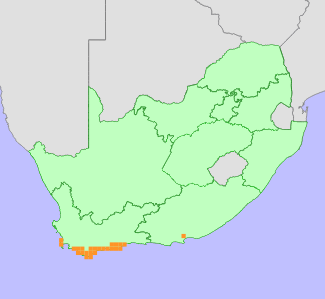|
Scientific Name | Protea obtusifolia H.Buek ex Meisn. |
Higher Classification | Dicotyledons |
Family | PROTEACEAE |
Synonyms | Protea calocephala Meisn. |
Common Names | Bredasdorp Sugarbush (e), Bredasdorp-suikerbos (a), Kalkrand-suikerbos (a), Limestone Sugarbush (e) |
National Status |
Status and Criteria | Near Threatened B1b(iii,v)+2b(iii,v) |
Assessment Date | 2020/06/03 |
Assessor(s) | A.G. Rebelo, H. Mtshali & L. von Staden |
Justification | Protea obtusifolia is a range-restricted species with an extent of occurrence (EOO) of 9426 km². It is however a locally abundant species with over 74 subpopulations known, many of which consist of dense stands of individuals. It is declining due to ongoing habitat degradation and over harvesting, but still remains at more than 10 locations. It therefore almost meets the thresholds for listing as Vulnerable under criterion B and is listed as Near Threatened. |
Distribution |
Endemism | South African endemic |
Provincial distribution | Western Cape |
Range | This species is endemic to the coastal areas of the Western Cape Province, South Africa, where it occurs from Stanford to Gouritsrivier. |
Habitat and Ecology |
Major system | Terrestrial |
Major habitats | Overberg Dune Strandveld, Canca Limestone Fynbos, De Hoop Limestone Fynbos, Agulhas Limestone Fynbos, Hartenbos Dune Thicket |
Description | It grows on limestone pavements and outcrops on coastal forelands, 0-400 m. Mature individuals are killed by fires, and only seeds survive. Wind-dispersed seeds are stored in fire-resistant inflorescences, and released after fires. It is pollinated by birds. |
Threats |
| Protea obtusifolia has lost 8% of its habitat to agricultural expansion. More than 20% of this species' limestone habitat continues to decline due to livestock farming and ranching, increasing densities of alien invasive plants and inappropriate fire management. It is also threatened by over-harvesting for the cut-flower industry.
Climate-change models in combination with land transformation models predicted that the population will decline by 20-30% by 2025 (Bomhard et al. 2005), but this seems unlikely, and drought related mortality has not yet been observed. Climate change therefore remains a potential threat. |
Population |
This species has a restricted range, but is known from dense, extensive stands. At least 74 different subpopulations have been recorded. The population is declining due to habitat degradation and over harvesting.
|
Population trend | Decreasing |
Conservation |
| It occurs in De Hoop Nature Reserve and Groot Hagelkraal, Brandfontein-Rietfontein, TFDC Armscor and Reins Private nature reserves. It has a life history type that is sensitive to over harvesting and monitoring as well as management of the harvesting of this species is required (Privett et al., 2005). |
Assessment History |
Taxon assessed |
Status and Criteria |
Citation/Red List version | | Protea obtusifolia H.Buek ex Meisn. | NT A2c+3c+4c | Raimondo et al. (2009) | |
Bibliography |
Bomhard, B., Richardson, D.M., Donaldson, J.S., Hughes, G.O., Midgley, G.F., Raimondo, D.C., Rebelo, A.G., Rouget, M. and Thuiller, W. 2005. Potential impacts of future land use and climate change on the Red List status of the Proteaceae in the Cape Floristic Region, South Africa. Global Change Biology 11(9):1452-1468.
Goldblatt, P. and Manning, J.C. 2000. Cape Plants: A conspectus of the Cape Flora of South Africa. Strelitzia 9. National Botanical Institute, Cape Town.
Manning, J.C. and Goldblatt, P. 2012. Plants of the Greater Cape Floristic Region 1: The Core Cape Flora. Strelitzia 29. South African National Biodiversity Institute, Pretoria.
Privett, S., Bailey, R., Raimondo, D., Kirkwood, D. and Euston-Brown, D. 2005. A vulnerability index for rare and harvested plant species on the Agulhas Plain. Flower Valley Conservation Trust.
Raimondo, D., von Staden, L., Foden, W., Victor, J.E., Helme, N.A., Turner, R.C., Kamundi, D.A. and Manyama, P.A. 2009. Red List of South African Plants. Strelitzia 25. South African National Biodiversity Institute, Pretoria.
Rebelo, T. 2001. Sasol Proteas: A field guide to the proteas of southern Africa. (2nd ed.). Fernwood Press, Vlaeberg, Cape Town.
|
Citation |
| Rebelo, A.G., Mtshali, H. & von Staden, L. 2020. Protea obtusifolia H.Buek ex Meisn. National Assessment: Red List of South African Plants version 2024.1. Accessed on 2025/11/15 |
 Comment on this assessment
Comment on this assessment

